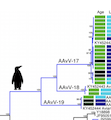Abstract
Wild birds harbor a huge diversity of avian avulaviruses (formerly avian paramyxoviruses). Antarctic penguin species have been screened for avian avulaviruses since the 1980s and, as such, are known hosts of these viruses. In this study, we screened three penguin species from the South Shetland Islands and the Antarctic Peninsula for avian avulaviruses. We show that Adelie penguins (Pygoscelis adeliae) are hosts for four different avian avulavirus species, the recently described avian avulaviruses 17 to 19 and avian avulavirus 10-like, never before isolated in Antarctica. A total of 24 viruses were isolated and sequenced; avian avulavirus 17 was the most common, and phylogenetic analysis demonstrated patterns of occurrence, with different genetic clusters corresponding to penguin age and location. Following infection in specific-pathogen-free (SPF) chickens, all four avian avulavirus species were shed from the oral cavity for up to 7 days postinfection. There was limited shedding from the cloaca in a proportion of infected chickens, and all but one bird seroconverted by day 21. No clinical signs were observed. Taken together, we propose that penguin species, including Antarctic penguins, may be the central reservoir for a diversity of avian avulavirus species and that these viruses have the potential to infect other avian hosts.
